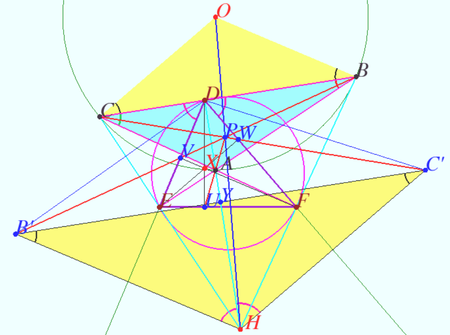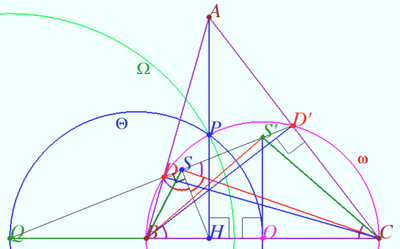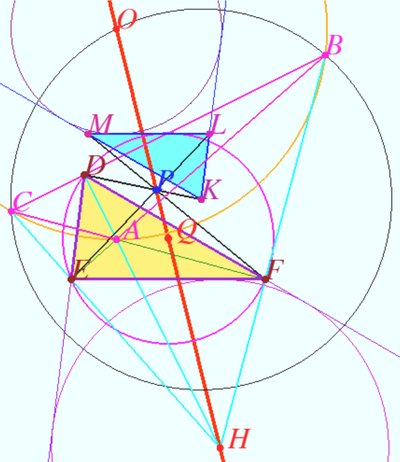Difference between revisions of "Kimberling’s point X(24)"
(→Theorem 2) |
(→Theorem 2) |
||
| Line 70: | Line 70: | ||
<math>LM</math> is the bisector of <math>AO,</math> therefore <math>LM</math> is antiparallel <math>BC</math> with respect <math>\angle A</math> | <math>LM</math> is the bisector of <math>AO,</math> therefore <math>LM</math> is antiparallel <math>BC</math> with respect <math>\angle A</math> | ||
| − | < | + | <cmath>\implies LM||EF.</cmath> |
Similarly, <math>DE||KL, DF||KM \implies \triangle DEF</math> and <math>\triangle KLM</math> are homothetic. | Similarly, <math>DE||KL, DF||KM \implies \triangle DEF</math> and <math>\triangle KLM</math> are homothetic. | ||
| + | |||
Let <math>P</math> be the center of homothety. | Let <math>P</math> be the center of homothety. | ||
| − | <math>H</math> is <math>D</math>-excenter of <math>\triangle DEF, O</math> is <math>K</math>-excenter of <math>\triangle KLM \implies P \in HO.</math> | + | |
| + | <math>H</math> is <math>D</math>-excenter of <math>\triangle DEF, O</math> is <math>K</math>-excenter of <math>\triangle KLM \implies</math> | ||
| + | <math>P \in HO.</math> | ||
| + | |||
Denote <math>a = BC, \alpha = \angle A, \beta = \angle B, \gamma = \angle C, R</math> circumradius <math>\triangle ABC.</math> | Denote <math>a = BC, \alpha = \angle A, \beta = \angle B, \gamma = \angle C, R</math> circumradius <math>\triangle ABC.</math> | ||
<math>\angle EHF = 180^\circ - \alpha, EF = BC |\cos \alpha| = 2R \sin \alpha |\cos \alpha|.</math> | <math>\angle EHF = 180^\circ - \alpha, EF = BC |\cos \alpha| = 2R \sin \alpha |\cos \alpha|.</math> | ||
<math>LM = \frac {R}{2} (\tan \beta + \tan \gamma) = \frac {R \sin (\beta + \gamma)}{2 \cos \beta \cdot \cos \gamma} \implies k = \frac {DE}{KL} = 4\cos \alpha \cdot \cos \beta \cdot \cos \gamma.</math> | <math>LM = \frac {R}{2} (\tan \beta + \tan \gamma) = \frac {R \sin (\beta + \gamma)}{2 \cos \beta \cdot \cos \gamma} \implies k = \frac {DE}{KL} = 4\cos \alpha \cdot \cos \beta \cdot \cos \gamma.</math> | ||
| − | + | <math>\frac {\vec {PH}}{\vec {OP}}= 4 \cos A \cos B \cos C \implies P</math> is point <math>X(24).</math> | |
| + | |||
'''vladimir.shelomovskii@gmail.com, vvsss''' | '''vladimir.shelomovskii@gmail.com, vvsss''' | ||
Revision as of 13:25, 12 October 2022
Kimberling's point X(24)
Kimberling defined point X(24) as perspector of ![]() and Orthic Triangle of the Orthic Triangle of
and Orthic Triangle of the Orthic Triangle of ![]() .
.
Theorem 1
Denote ![]() obtuse or acute
obtuse or acute ![]() Let
Let ![]() be the base triangle,
be the base triangle, ![]() be Orthic triangle of
be Orthic triangle of ![]() be Orthic Triangle of
be Orthic Triangle of ![]() . Let
. Let ![]() and
and ![]() be the circumcenter and orthocenter of
be the circumcenter and orthocenter of ![]()
Then ![]() and
and ![]() are homothetic, the point
are homothetic, the point ![]() center of this homothety lies on Euler line
center of this homothety lies on Euler line ![]() of
of ![]()
The ratio of the homothety is ![]()
Proof
WLOG, we use case ![]()
Let ![]() be reflection
be reflection ![]() in
in ![]() In accordance with Claim,
In accordance with Claim, ![]() and
and ![]() are collinear.
are collinear.
Similarly, ![]() and
and ![]() were
were ![]() is reflection
is reflection ![]() in
in ![]() are collinear.
are collinear.
Denote ![]()
![]()
![]()
![]()
![]() and
and ![]() are concurrent at point
are concurrent at point ![]()
In accordance with Claim, ![]() points
points ![]() and
and ![]() are isogonal conjugate with respect
are isogonal conjugate with respect ![]()
![]()
![]()
![]()
Claim
Let ![]() be an acute triangle, and let
be an acute triangle, and let ![]() and
and ![]() denote its altitudes. Lines
denote its altitudes. Lines ![]() and
and ![]() meet at
meet at ![]() Prove that
Prove that ![]()
Proof
Let ![]() be the circle
be the circle ![]() centered at
centered at ![]() is midpoint
is midpoint ![]()
Let ![]() meet
meet ![]() at
at ![]() Let
Let ![]() be the circle centered at
be the circle centered at ![]() with radius
with radius ![]()
Let ![]() be the circle with diameter
be the circle with diameter ![]()
Well known that ![]() is the polar of point
is the polar of point ![]() so
so ![]()
![]()
Let ![]() be inversion with respect
be inversion with respect ![]()
Denote ![]()
![]()
![]()
![]()
Theorem 2
Let ![]() be the base triangle,
be the base triangle, ![]() be orthic triangle of
be orthic triangle of ![]() be Kosnita triangle of
be Kosnita triangle of ![]() Then
Then ![]() and
and ![]() are homothetic, the point
are homothetic, the point ![]() center of this homothety lies on Euler line of
center of this homothety lies on Euler line of ![]() the ratio of the homothety is
the ratio of the homothety is ![]() We recall that vertex of Kosnita triangle are:
We recall that vertex of Kosnita triangle are: ![]() is the circumcenter of
is the circumcenter of ![]() is the circumcenter of
is the circumcenter of ![]() is the circumcenter of
is the circumcenter of ![]() where
where ![]() is circumcenter of
is circumcenter of ![]()
Proof
Let ![]() be orthocenter of
be orthocenter of ![]() be the center of Nine-point circle of
be the center of Nine-point circle of ![]() is the Euler line of
is the Euler line of ![]() Well known that
Well known that ![]() is antiparallel
is antiparallel ![]() with respect
with respect ![]()
![]() is the bisector of
is the bisector of ![]() therefore
therefore ![]() is antiparallel
is antiparallel ![]() with respect
with respect ![]()
![]() Similarly,
Similarly, ![]() and
and ![]() are homothetic.
are homothetic.
Let ![]() be the center of homothety.
be the center of homothety.
![]() is
is ![]() -excenter of
-excenter of ![]() is
is ![]() -excenter of
-excenter of ![]()
![]()
Denote ![]() circumradius
circumradius ![]()
![]()
![]()
![]() is point
is point ![]()
vladimir.shelomovskii@gmail.com, vvsss












